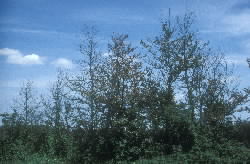Tools and Resources
We use some essential cookies to make this website work.
We’d like to set additional cookies to understand how you use forestresearch.gov.uk, remember your settings and improve our services.
We also use cookies set by other sites to help us deliver content from their services.
Dutch elm disease is one of the most serious tree diseases in the world. Bark beetles spread the fungus that causes the disease, which triggers foliage and tip dieback in all of Britain’s major native elms: English elm (Ulmus procera), smooth-leaved elm (U. carpinifolia or U. minor) and wych elm (U. glabra).
The disease first spread to Britain in the 1920s, when it killed 10-40% of elm trees. Although the initial epidemic died down, a more aggressive species of Dutch elm disease fungus was accidentally introduced into Britain in the 1960s.
An epidemic rapidly took hold of lowland central and southern Britain – where there were predominantly English elms – in the early to mid-1970s. By 1980, most mature English elm had died. Scattered escapes and pockets of mature elm occasionally survived, for example in Brighton and Hove, where the geographic situation has facilitated an effective and continuing sanitation control programme.
However, by the late 1980s the bark beetles used up most of the mature elms that they relied on for breeding material, so beetle populations declined and the disease virtually disappeared from many southern and south-western areas.
During this period enormous numbers of suckers grew from surviving roots of English elm and some smooth-leaved elm types, together with occasional young seedlings of wych elm. Also many small hedgerow elms that escaped the second epidemic matured, in some cases through careful husbandry, but often through an absence of hedgerow maintenance. Consequently a numerically massive and increasing elm resource developed, mainly of small to semi-mature U. procera, across much of southern Britain. From Essex to the Welsh borders the trees probably numbered many tens of millions.
In 1982, Forestry Commission research on the biology of O. novo-ulmi and disease transmission and its recent spread across Eastern Europe (Romania to Poland) was combined to produce a prognosis for the future of the disease and elm. This suggested that the disease would not decline in intensity in contrast to the first epidemic, caused by O. ulmi. Instead the new pathogen, O. novo-ulmi, would return in a continuing cycle to attack the following generation of small elms once they were large enough to support beetle breeding. Today we can see this happening in much of southern Britain.
The Forestry Commission established 20 elm plots across the south of England. Between 1980 and 1990 only about 1% of regenerating elms were killed annually, but disease reappeared on a significant scale after 1991. Around the Research Station in the Farnham-Guildford area, no trace of the disease was found during 1981 to 1987, then two separate infections were seen near Godalming in 1988. By 1990 new infections were scattered across the whole area. By 1994-5, substantial tracts of hedgerow elms 3-12 m high were dead or dying.

Pictured left are young hedgerow elms dying from Dutch elm disease at Jacobs Well, Guildford, Surrey, England
This pattern of renewed disease has now occurred across most of the old 1970s U. procera disease-outbreak areas. Indeed, the current disease situation is often remarkably reminiscent of the mid-1970s, except that the affected elms are much smaller. About 20 years separate each wave of disease from the initial outbreak.
Key points
Dutch elm disease remains one of Britain’s most destructive tree disease. However, although further cycles of disease can be expected, elm will survive to provide a potential contribution to future landscapes.
Cookies are files saved on your phone, tablet or computer when you visit a website.
We use cookies to store information about how you use the dwi.gov.uk website, such as the pages you visit.
Find out more about cookies on forestresearch.gov.uk
We use 3 types of cookie. You can choose which cookies you're happy for us to use.
These essential cookies do things like remember your progress through a form. They always need to be on.
We use Google Analytics to measure how you use the website so we can improve it based on user needs. Google Analytics sets cookies that store anonymised information about: how you got to the site the pages you visit on forestresearch.gov.uk and how long you spend on each page what you click on while you're visiting the site
Some forestresearch.gov.uk pages may contain content from other sites, like YouTube or Flickr, which may set their own cookies. These sites are sometimes called ‘third party’ services. This tells us how many people are seeing the content and whether it’s useful.